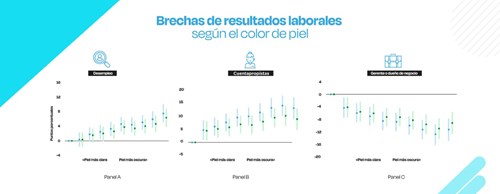Labor Inequalities and Opportunities for Intergenerational Mobility
May 01, 2023
Latin America and the Caribbean shows significant labor gaps among its people, in labor force participation, unemployment, wages and quality of jobs. According to the 2022 Economy and Development Report of CAF—development bank of Latin America—, job performance is strongly influenced by family background. Adults from lower socioeconomic status—as measured by maternal education level—show an unemployment rate between 1 and 3 percentage points higher, a formality rate 22 percentage points lower, and earn half the wages compared to those from higher status.

These socioeconomic gradients, moreover, vary between men and women. For example, labor force participation rate of women from families at upper socioeconomic status is 17 percentage points higher than those from families of lower socioeconomic status. In a region where female force labor participation is still very low, this difference is substantial.
The gaps in job performance between people of different family socioeconomic status are derived in part from the differences in the educational levels and skills that they managed to attain in the stages before entering the labor market. However, even if we compare workers with the same formal education and productive skills, the Report shows that differences in their employment outcomes persist. This suggests that there are mechanisms in the labor market that help reproduce inequality between generations.
The EDR 2022 documents various mechanisms through which parents impair their children’s job opportunities, with two notable examples. First, wealthier families have more contacts and access to information that influence job opportunities of the new generations. CAF surveys have shown that the help of acquaintances, relatives and friends is used often to land jobs in the region. For instance, the 2016 survey showed that 1 in 3 jobs in large cities in the region were secured thanks to the help of acquaintances. The 2021 survey confirmed that relatives are the top source of job referral.

Second, families tend to determine key factors for job performance, such as education, ethnicity, race, and geographic location, between regions and within cities. Historical inequalities by ethnicity and race in the region create large gaps in employment outcomes. For example, in an average for 21 countries in Latin America and the Caribbean, unemployment rate among darker-skinned adults is 7 percentage points higher than among lighter-skinned adults (Figure 1.A). These differences are due only marginally to educational inequalities by ethnicity and race (as shown by the light blue dots in Figure 1.A), and thus, discrimination in the labor market arises as a plausible explanation..
Skin color also affects factors such as the type and quality of jobs that people can access. For example, the likelihood of working as a self-employed individual is 10 percent higher for darker-skinned people than for lighter-skinned people with the same educational attainment (Figure 1.B), while the likelihood of being a manager or business owner is 11 percent lower (Figure 1.C).
Against this backdrop of inequalities, public policies are needed to transform the labor market into a setting that offers real opportunities to all workers, regardless of their family background. The EDR 2022 puts forward a series of tools to intervene in the region’s labor markets and reduce the legacy of inequalities between generations. Active job-promoting policies, such as job training programs and internships for adults, help bridge productive capacity gaps among workers and produce valuable information for the job hunting process. Job boards and job assistance programs are also helpful in reducing information asymmetries, by equalizing knowledge about job opportunities.
Social protection policies for adults also play a pivotal role in reducing labor inequalities. Access to better jobs requires time and resources for training and job search. Unemployment insurance and income transfer programs can provide the livelihood support needed to avoid survival jobs. Lastly, forceful action is required to implement anti-discrimination policies, both at work and in education systems and other areas of culture.

Guillermo Alves
Economista Principal, Dirección de Investigaciones Socioeconómicas, CAF -banco de desarrollo de América Latina-

Dolores de la Mata
Economista Principal, CAF -banco de desarrollo de América Latina-

